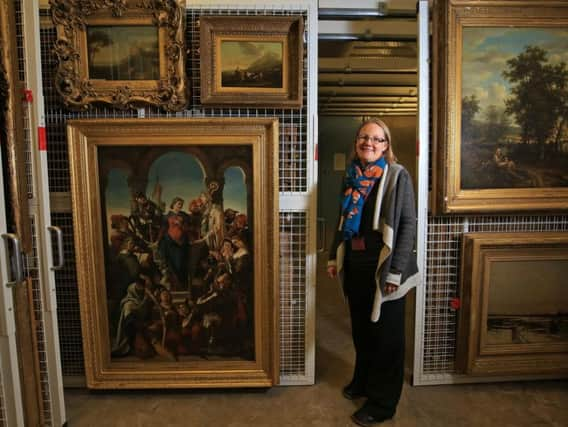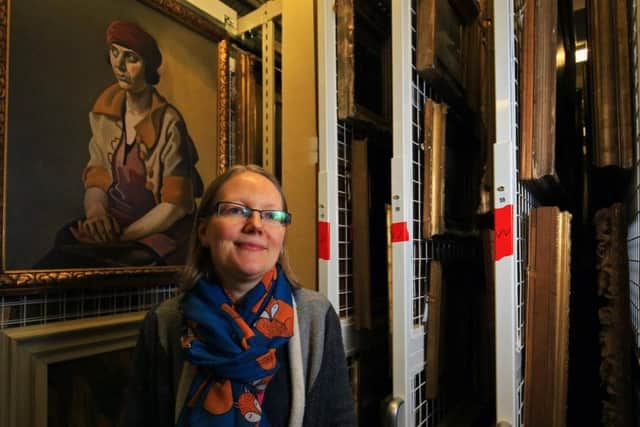A chance to discover Sheffield's treasure trove


The location of Museums Sheffield's store isn't widely publicised for security reasons, and on stepping inside the secrecy becomes understandable.
It is a place filled with irreplaceable items - chiefly, gems from the city's art collection, but there are also examples of the trades that gave Sheffield its reputation for manufacturing, everyday artefacts that carry stories of past lives and finds that shed light on the natural world.


Advertisement
Hide AdAdvertisement
Hide AdHowever, more highlights from the store could soon be on display publicly rather than sitting in storage. Last year the council announced its intention to upgrade the Graves Gallery and Central Library in the city centre, turning it into a landmark 'cultural hub' after the idea of creating a five-star hotel at the building with Chinese investment money failed to gain momentum.
In a series of special features for the next five weeks, The Star takes a look at what visitors to the arts centre could expect to see, and how Museums Sheffield wants to make more of its huge archive as the gallery redevelopment plans take shape.
The collections, as chief executive Kim Streets explains, have grown extensively since being founded on the gifts given by Sheffield's literary and philosophical societies in the early 1800s. Members were 'out in the world, collecting things to use as education tools', she says. "It's about bringing the world to Sheffield and, on their travels, taking Sheffield out into the world as well - taking a product out on a trade journey, for example."
We begin with the visual art collection. This encompasses 6,000 paintings, sculptures, photographs, drawings, prints and watercolours, which any new exhibition space would primarily draw from.


Advertisement
Hide AdAdvertisement
Hide AdSian Brown, head of collections, leads the way into a room where oil and acrylic paintings are hung carefully on rolling metal racks. The works are drawn from two major bequests left by businessman John Newton Mappin and entrepreneur John George Graves, both of whom were recognised with galleries in their name.
Mappin's tastes were typical of the late 19th century, says Sian. "There are lots of landscapes, and what we lovingly call 'cow paintings'."
Graves had a 'slightly different perspective', making more astute purchases and securing some impressive pieces such as The Hours, by Edward Burne-Jones, and Roger Fry's portrait of Edith Sitwell, which Sian describes as 'real cornerstones of the collection'. "He gave a lot to the city and I don't think we said 'no' to anything."
Later, in the 1960s, 70s and early 80s, several forward-thinking directors made their mark. Frank Constantine emerged as the most prominent and influential, using his network of connections - dealers, auction houses, artists - to make acquisitions that put Sheffield on a par with the country's biggest regional galleries.
Advertisement
Hide AdAdvertisement
Hide Ad"He was very good at getting good deals, having a very good eye for the right work and having a connection with an artist. His influence managed to buy works which nowadays are way beyond even our dreams, really."
David Bomberg's Valley of La Hermida, usually on display at the Graves, was bought by Constantine and would now be worth hundreds of thousands of pounds. "He bought them when they weren't that fashionable."
He didn't shy away from more progressive, contemporary work, either. "Some of the larger canvases we've got, huge Bridget Rileys and things like that - came from that ethos of supporting contemporary work as well as looking back."
Around the room there are paintings wrapped up in crates, a reflection of how much work Sheffield loans out - one consignment has returned from the National Galleries of Scotland, while another has been to Southport.
Advertisement
Hide AdAdvertisement
Hide Ad"Tate are always asking for key works," says Sian. "Frequently loans are for works we haven't got on display, which is fantastic."
She casually rolls out a rack, turning the space into an impromptu gallery, and points out a piece by American artist William Harnett. "There aren't any other Harnett works in this country in public collections. It's been on tour to London, Bristol and Newcastle, and next year it's going to Germany to go in a still life exhibition. It gets circulated around."
Sian then pulls out a Victorian painting by Daniel Maclise called The Spirit of Chivalry. Rich in symbolism, it is a cartoon for a series of larger friezes in the Houses of Parliament.
A self-sufficient approach has been taken at the Graves and Millennium Galleries, and Weston Park Museum, in recent years, says Sian, putting away a colourful Patrick Caulfield canvas.
Advertisement
Hide AdAdvertisement
Hide AdThe aim has been to find exhibitions drawn almost exclusively from Sheffield's existing reserves. "We had Leonard Beaumont, we had Stanley Royle - all of those were really from our own collections."
But conservation is an ongoing challenge. Some paintings are in an excellent condition, but others are faded and tarnished, among them a sad-looking 17th century Dutch painting of flowers in a sculpted vase. "I've probably shown you our worst," Sian comments.
When Museums Sheffield took on the collections in the late 1990s the store faced difficulties, one being that pictures had been stored leaning against each other, affecting the frames especially badly. The organisation has no conservation budget, relying on appeals and generous friends instead.
"If something's at risk and it's going to deteriorate, we will take action. If we want to display something, we'll build an appeal around it."
Advertisement
Hide AdAdvertisement
Hide AdWorks on paper are kept at the Millennium Gallery, and the rest is at the store, which anyone can visit, given enough notice. "If anybody wants to see anything they can. The only thing we're limited with is numbers. But it's open in that sense."
Kim admits that 'of course' Museums Sheffield would 'like to get more out there'. "It would be great if we could expand in the store, it would enable more people to visit and to get more out of it. At our other sites we use every bit of space we can. But that is the great opportunity around the Graves and the library building, to get more of this on display."
Next week The Star looks at the museums’ social history collection.